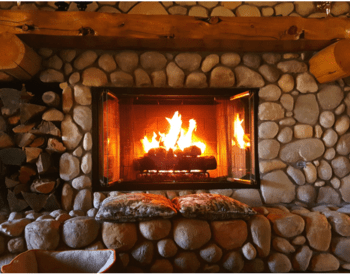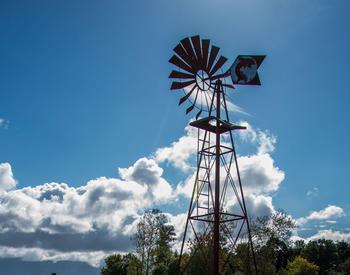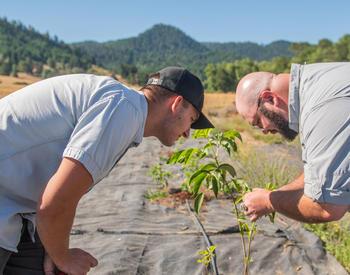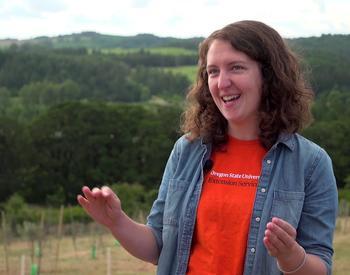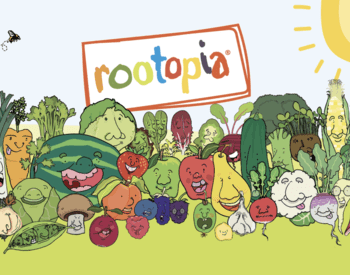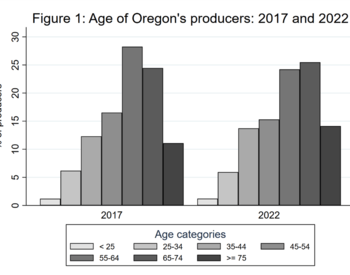Transcript
00:00:11 Rick
Welcome to the farm to school podcast where you will hear stories of how youth thrive and farmers prosper when we learn how to grow, cook and eat delicious, nutritious local foods and schools across the country and the world. I'm your co-host, Rick Sherman, along with me. As always is Michelle Markesteyn. And thanks for coming by. What follows is part two of our two-part interview with Andony Melanthopoulos with Oregon State University, entitled What's The Buzz in School Gardens, Part 2?. Let's pick up right where we left off.
00:00:47 Michelle
So everyone is caring about bees and being in the school garden world. Seeing it more and more and people are interested in it, and there's a lot of different considerations and going into it.
00:00:55 Rick
Yeah. Thank thank you for that, Michelle, because this is a school garden farm to school podcast. We were going to get there. Yeah. But we were like, yeah, but…
00:01:03 Michelle
After the chutney..
00:01:08 Rick
Andony, you have been very much involved in the schools and tell us a little bit more about that journey.
00:01:15 Andony Melanthopoulos
Well, I would say that journey starts with Lauren Tobey and the amazing group at FoodHero at OSU. That initiative. Well, I actually think it started for me. I remember before meeting Lauren. And meeting you, Rick, and trying to think about this is like how can we provide some content? That's to school gardens. Like what's our role? And I couldn't figure it out. Like it kept coming up with these ideas and they just weren’t that great.
00:01:40 Rick
You invited me to the pollination conference. As and so I spoke there and I think that was the first time anybody.. I said you guys should all have bee colonies in school gardens. And people are like, whoa.
00:01:44 Andony Melanthopoulos
Yeah.
00:01:55 Rick
You know, but I we keep track of that and I think at last count we had like 60 school gardens that had some sort of pollinators like Mason bees or honey bees or whatever you know there. But..
00:02:10 Michelle
And we have a lot of school gardens that put in, they call them pollination gardens. So even if they're not also creating habitat, which they are more and more, they're creating foods, but we get that question a lot too.
00:02:21 Rick
But and then you tell us about that. Like, yeah, people sometimes can be squeamish about getting bees on school properties.
00:02:30 Andony Melanthopoulos
Yeah, for sure and well, let me just put a bow on that last part. Yeah, it was Lauren who finally cracked the nut and we'll maybe we can come around back to it on how we could provide a kind of a framework for not only giving educators some resources to work with, but thinking about a pathway. But let's back up to that question. So I get it a lot. I am a school garden coordinator. I'm trying to convince the principal and the parents that having bees on as part of the school garden is going to be safe. This always comes up and it's always this issue that everybody has, and I think the key parts to that are, uh, when it comes to honey bees, there is some risk. So honey bees are, you know, can, sting, unlike Mason bees, which is another option which I think is people often overlooked. But there's a number of counties in Oregon that have done a really good job of it.
00:03:38 Rick
Now, Mason bees. I've always heard, oh, they don't sting. They do sting, but just not…
00:03:46 Andony Melanthopoulos
You have to get it like in your palm of your hand and you have to like, squeeze like it? Well, not. You can sit within. You can take your face within two inches of where they're flying in and out, and then we'll just, like, go around your nose because they're trying to get in. They they're totally not defensive.
00:04:02 Rick
Yeah, well, and I was at a garden last spring in Corvallis at College Hill High School, and I put my face by a hive and on one nailed me right in the center of my forehead. It was a honeybee, not a Mason.
00:04:14 Andony Melanthopoulos
A honey bee, a honey bee? Yeah.
00:04:17 Rick
So, but that goes to show you another time. I was at Michele's school near her house in 91 School in Canby, and I was asked to talk about something, and for some reason it was that they had bees. And the kids were flipping out just because of bees, you know, “run for your lives!” And one landed on my finger and I said, look, you guys, I'm so lucky. I got one to land, you know, and I'm not going to lie, it could sting and it's going to hurt. But then, you know, I was telling them all the wonderful things they do, and we need these guys to pollinate our food, so we can eat and everything. Pretty soon all the kids were running around with their fingers out trying to get one and one. Like, look, Mr. Sherman, look, I got one on my finger. So you model that behavior and there might be some kids that do have an allergy or something, but usually the teacher they know about that kid and they have, you know, help nearby forum and stuff and it tends not to be an issue right? So…
00:05:19 Andony Melanthopoulos
I love it. It all has to do with the placement of the colony, where it's going to be placed on in the garden, yeah. Setting some kind of a boundary around the colony and having a beekeeper who's experienced. I know there's, you know, a number of commercial nurseries where the public is walking within, you know, a foot of a bee colony and there's no issue. It really does require some experience. I will say though, with Mason bees it requires.. There's zero… I really think the risk with Mason bees is so low. Yeah, but the problem, I think, is when it comes to parents and administrators, they don't really know the difference between a yellow jacket and a bee. And they they're thought of when you bring bees onto a school ground is those things that stung them in the ankle.
00:06:05 Rick
Yeah.
00:06:08 Andony Melanthopoulos
When they were mowing the grass, that's what they're thinking of.
00:06:11 Michelle
Maybe we should we should do a bee rebrand?
00:06:14 Rick
Yeah, well, well, the good news I see, like when you go to your big box stores, your home depots, your Fred Meyer or Krogers. Whatever.. I see Mason bee houses all the time. They're the ones that have the like, the little straws. And then where they go in and they nest and they're they look like they could look like anything. Bird houses or tubes or whatever.
00:06:21 Andony Melanthopoulos
The idea I like that.
00:06:38 Michelle
OK, so bees are cool. Bees pollinate and people are increasingly interested in them. Although they're worried about them. But let's be real. Bell time and school time is really they already have limited instructional time there, so.
00:06:50 Andony Melanthopoulos
Yeah.
00:06:52 Michelle
Where is the connection between educational standards and Bees.
00:06:57 Andony Melanthopoulos
Well, this is where Lauren comes in. I think food hero has really. I've been amazed. I guess you you folks had had worked with food hero in the past and realized, you know what a powerhouse they are.
00:07:09 Rick
Michelle, could you explain what FoodHero is for us, Michelle?
00:07:10 Michelle
I'm on the food hero team.
00:07:12 Andony Melanthopoulos
Ohh please. Oh yes.
00:07:16 Michelle
Well, at Oregon State University Extension operates Snap Ed education in the state of Oregon through a partnership with the Department of Human Services and funded by the United States Department of Agriculture. It's worth saying all those different layers of government because what it does is it really plays out to our snap Ed. A lot of our programming comes down to FoodHero, and so you can Google it up and...
00:07:38 Rick
It's foodhero.org and I'll drop a link in the show notes, but that's it foodhero.org.
00:07:44 Michelle
And we do all kinds of amazing, delicious, tasty, affordable recipes. We now are really blowing out our school garden content related to different tip sheets related to how TOS and then our big push has been this Bee book working.
00:08:04 Andony Melanthopoulos
And the B book? Well, the Bee book and the Bee videos. And it is. Yeah. Like I've just been astounded at the productivity in some ways. It's one of the most exciting collaborations I've ever been involved with because you just float an idea and then about a few weeks later, there's a fully constructed page. That's biologically accurate, is engaging and written at a level for the students that I can't do like I can. I can only write it like whatever my default level is which I don't know what it is.
00:08:35 Michelle
It's an app for that they can. They can actually tell you. And yeah, actually at the time of this recording, it's one of our goals to get B books into the hands of every single 4th grade student as part of their curriculum. So we're really excited about that partnership with the Department of Education and you and schools across the State.
00:08:52 Andony Melanthopoulos
It's remarkable at. I don't think there's another program like this in terms of education on pollinators anywhere in the nation. It's and it's really rigorous, like the thing I love about it is, you know, I remember the very first time the conversation started. I think it was around some kind of like, bookmark with a puffy bee with, like, googly eyes. And I was like, I don't know. I don't know if I can help you, but I didn't quite realize that you could turn something out that had covered every facet connected it back to Oregon agriculture in a in a very in a meaningful way, not just the generic way. Like, oh, bees pollinate, it's like, here are the crops. And here are the bees that visit them and we're going to take you down the pathway of bee biodiversity in a way that you're not just going to be. Reiterating the stuff that you see on TikTok, you're going to learn something and I thought that was, you know, a remarkable feat.
00:09:57 Michelle
Thank you. And I do encourage our listeners to check it out because a lot of the things that are talked about in there, it's really an activity book you could do with your students or at home and even though it's geared for 4th grade. You really can enjoy it as an adult with there's recipes and different activities and you know focusing on many foods, First foods are when wild bee pollinated, which is important, and you meet really funny bees in there like the squash and others.
00:10:27 Andony Melanthopoulos
That was a great example, just that the last thing I remember, we were just in the hallway and I think, Rick, you were there where we're talking about, wouldn't it be fun to have, like, these cards that you had as a child that you'd get a stack of cards with different properties, maybe airplanes or cars? And one has a big engine, one has a small.. The engine and you put the card down with somebody else and you kind of like have a card game and we cooked up in the hallway. It's an insert you can like, you can separate them out. They're perforated these card deck.
00:11:00 Michelle
Yeah, we got trading cards for bees. And even if you can't get a hard copy of it, it's all free on the website and you just download it as a PDF.
00:11:09 Rick
Again, we'll we'll leave links. Yep.
00:11:10 Andony Melanthopoulos
Amazing.
00:11:12 Michelle
So what's the most common question you get from school gardens, and bees?
00:11:16 Andony Melanthopoulos
Ohh I get the question of first question that we've already covered is how do I deal with this? You know liability issue and there are just the recap. I think it is with honey bees, you do require a little bit of a little bit of skill like you can't just pull off beekeeping. It is complicated. You're going to need to set the colonies in a specific pat of the garden to mitigate the risk. But when it comes to Mason bees, the risk is low and I think the great example of this is up at the schools of Washington County. Ron Spender, with the Master Gardeners, has done a remarkable job of creating these display Mason bees where the students can actually take back peel back the curtain and see the bees at work, so there's great examples of this lower risk, an easier way to get in and the bees are flying during the school year, which makes them ideal.
00:12:05 Rick
I've seen I was at a school garden conference and we were up in a school and they had the bee colony on the outside of the building and they had plexiglass on the inside of the classroom, so you could watch them doing their thing, their honeycombs and stuff. And you could, you could watch them without disturbing them and see what they're doing. And they were, they were coming and it was on the 2nd floor, way up top, you know, so it was really cool.
00:12:18 Andony Melanthopoulos
Oh yeah. Yeah. So they've, they've mitigated the risk and you've got this nice thing in the classroom where you can talk about, you know Biology.
00:12:29 Rick
00:12:33 Rick
And then another so part of Part 2 of Michele's question, what do you get asked? Do you get asked? Like what kind of plants shall I plant to attract bees or pollinators? And I remember when I came to your conference, I thought oh, any flower should do the trick, like mums or whatever, and it's like, no, they don't like those flowers really. Or So what? What do you what would your answer for that question?
00:12:58 Andony Melanthopoulos
That is the second most asked question. So good that was really timely and I think there there's a couple principles obviously. Well, first of all Oregon State University does have a resource called enhancing. It's going to be in the show notes, enhancing urban landscapes or pollinators.
00:13:14 Rick
OK.
00:13:18 Andony Melanthopoulos
We have a number of plant lists and the plant lists are arranged in a way to do 2 things. The first one is to get the ones that are attractive, so there's bees. They're plants that are be attractive but also to stagger them through the year because the bees are not just uniformly active, they it's funny because there's some bees that are active in the spring. There's some bees that are active later in the summer. And there are some bees, like honey bees and bumblebees, that are active the year long. So you need to make sure that the bloom is going to be overlapping. There is an additional issue that some bees have very specific requirements, so one that everybody is going to have and you'll see it now after I tell you.
00:13:58 Andony Melanthopoulos
There are bees late in the summer. A whole genus of bees, the Longhorn bees genus Melissodes for the geeks out there. Thank you. They will only go to ..
00:14:06 Michelle
Yeah, Melissa.
00:14:11 Andony Melanthopoulos
They only go to composites, so you'll see them on a sunflower when you grow sunflowers, you'll see these bees. The males have these ridiculously long antennae and they'll just be going round and round the sunflower to all those little florets inside the flower. The males have the long antenna. The females have these big hairy chaps on the back of their leg. They will only be found on those. So if you have none of those in your school garden. You'll never.. you'll they won't show up.
00:14:37 Rick
I've noticed my artichokes when they when you grow an artichoke and it goes to bloom, it's this beautiful purple flower and you, you get what I call the big giant bumblebees on those. They're like those, well, big bumblebees.
00:14:47 Michelle
Very scientific. Rick is very scientific.
00:14:53 Andony Melanthopoulos
And also I love with the artichoke. It just jiggles, like the flowers, are just jiggling. You can't quite see the bees. It's just like it's a jiggle of flower petals.
00:14:55 Rick
Yeah.
00:15:00 Michelle
So to your point, I know I'm promoting a lot of food hero resources, but we really have so much on there, but we're going big on the sunflower, so we're blowing out a whole other tool kit that will be posted probably by the time of this recording for that exact purpose. So are there any plants not to plant?
00:15:14 Rick
Cool.
00:15:19 Andony Melanthopoulos
No, I always… I'm. I'm not a purist. I think it's totally OK that there are some flowers that won't provide benefits for bees. So an example of this is you may have one thing that I just one example of this is double petals, so you may have roses, right? And the single petal roses are great. They have nectar and pollen available in them. But if you go for the double petaled roses, what they've done is they've bred the stains. The male part that produces the pollen into an extra row of petals. And so there's no more pollen left in the flower. And the bees can't get in. You could grow it because it's a pretty flower and everybody should enjoy pretty flowers, but just be under no illusion.
00:16:00 Michelle
Yeah, I grow a purple variety of purple aster that's quite tall because it blooms in November, and we have a few days in November that warm up and they're just swarmed with different, right?
00:16:11 Andony Melanthopoulos
Those I would.. let me put a plug out. I think you know those purple asters are we have the native ones. We have a number of native ones that can get a little aggressive in your garden, but we also have you know, New England daisies. They are great for bees. They come at a time of year late in the season where everything is dried up and these are really water wise composites and they're great, I agree. All hail the purple daisies.
00:16:39 Michelle
All hail. Whatever works. Hello, composites.
00:16:41 Rick
OK. This sounds really good. And this has been one of my most fun podcasts. Is there any podcast you can go to? I don't know. Why. That's funny. That was most fun… Funnest. I was going to say funner…?
00:16:58 Michelle
OK, I declare that funner is a word.
00:17:01 Andony Melanthopoulos
Funner.
00:17:01 Michelle
Does anyone here agree with me?
00:17:03 Andony Melanthopoulos
It's funner. This this episode is funner.
00:17:06 Rick
I think wow, this will never make the cut.
00:17:06 Michelle
It's funner.
00:17:10 Rick
My question is, is there any podcast that you know of where you can we you can tune in and listen to just pollination items all the time.
00:17:19 Andony Melanthopoulos
Yeah, you could. Yeah. So I think thank you, Rick. I do have a I do have a podcast called pollination. I did set it up. I don't know what your guys’ motivation for the.
00:17:21 Rick
I'm setting him up here.
00:17:29 Andony Melanthopoulos
In fact, we're going to record a podcast after this with Michelle and Rick because I want to.
00:17:38 Michelle
That'll be even funner than this one.
00:17:40 Andony Melanthopoulos
But I was I was real, yeah, funner.
00:17:44 Andony Melanthopoulos
It works, but I did it. My original motivations was I knew there was a lot of people doing things with pollinators across the state, but I didn't know them all and I knew I thought I'm going to discipline myself to have a conversation with somebody new frequently so that I could learn what they're doing. So I did it with the anticipation. There would be no listeners. I started the show with like it's going to be janky and you know it's gonna be rushed, but I'm gonna just try to talk to as many people as I can. I've done it. I've done it with podcasts outside the washrooms, at a meeting where I've just said, hey, that talk you gave was great. and pull out a phone and we just start talking so that it's like that.
00:18:23 Michelle
But it turns out you have a lot of listeners and people who are very excited about literally pollen-ntion.
00:18:30 Andony Melanthopoulos
I know it. Yeah, it was amazing. It is amazing to me and I imagine the same thing that you found is that there is a, you know, you start a podcast in some, I don't know, you start a podcast in some ways because you're trying to, you know, learn something. And then you find out it’s good. People are intersted
00:18:43 Rick
Well, we we've actually are trying to solve for a problem. There was no farm to school podcasts. And we wanted to listen to one, and it was like there isn't one. So let's just make our own. And so with the idea, we would have DOZENS of listeners, you know? And but hey, you know, so far we've been in all 50 States and a couple dozen countries. And it's basically for the people… we found out we have two audiences, the practitioners, the people like us and foodservice and school garden coordinators, but the idea is to get farm to school out and be more of a household world and give it out to the people that don't know about it at all. But that's us.
00:19:28 Andony Melanthopoulos
Well, I have to say this is for those of you who can't see what I'm seeing. This is a very professional, awesome setup. I'm gonna go home and be sad about the state of my podcast.
00:19:39 Andony Melanthopoulos
But this is very professional, very professional.
00:19:40 Michelle
So as we're nearing the end of this podcast, what else is? What's one thing you want to make sure that everybody knows.
00:19:48 Andony Melanthopoulos
Oh, I have a couple of things. So one thing is a lot of the work that we're doing in Oregon is really unique and there's a license plate out there. If you're in Oregon, that license plate supports the taxonomist, who identifies all the strange and weird bees. So if you are at all interested in the stuff you've heard about, want to support it. Just get one of those plates.
00:20:09 Rick
Yes, and we I have that on your website too and it'll be in the show notes for everyone I'm sorry for those people outside of Oregon that can't get, you know, I'm sure you might have your own in your state, though, so check that out for, you know, every state has different license plates you get. That's a really good idea.
00:20:25 Michelle
No one. No one has a Bee license plate. Come on.
00:20:29 Rick
No, probably I don't know.
00:20:30 Michelle
I think so.
00:20:30 Andony Melanthopoulos
I don't know. No, they do, but they don't have one. That was designed by a 16 year old..
00:20:37 Michelle
That's so cool. So what did you do? Did you have, like, a? Did you ask that student or how did you?
00:20:43 Michelle
I think it was at a competition.
00:20:43 Rick
Have a contest?
00:20:44 Andony Melanthopoulos
Here's what we did. So it was during it was during COVID we had, we started our program off and we did it with zoom and there was this person with the camera off whose name was Merrick Stanton and asked all these really complicated question. I was sure he was 65 and he was German. And then one day, he sent me a graphic novel of Anthophora boites this bee that nests, and I realized he wasn't 65. Wow, he was and it turned out he was, you know, at the time 14. And so when we were going to design the plate, it was seen. We looked around to various people and we said, well, let's see if Merrick could draw one and we had all these fancy designers and Merricks was just way more compelling.
00:21:30 Michelle
I love that.
00:21:31 Rick
Yeah, I want one for my car. And then Andony has one right outside our house. OK. So yeah, thank you so much for being a part of our show, Anthony
00:21:53 Michelle
And thank you everyone so much for listening today.
00:21:57 Michelle
We really appreciate your time.
00:22:00 Rick
Yeah. Thank you. Farm to school was written, directed and produced by Rick Sherman and Michelle Markesteyn and was made possible by a grant by the United States Department of Agriculture.
00:22:09 Michelle
The content and ideas of the Pharma School podcast does not necessarily reflect the opinions of Oregon State University, Oregon Department of Education, or the United States Department of Agriculture. The USDA, Oregon Department of Ed and Oregon State University are equal opportunity providers and employers.
00:22:25 Rick
Do you want to learn more about Farm to school? Check out other episodes, show notes, contact information and much more by Googling Farm to school, podcast, OSU and that'll get you there.
00:22:35 Michelle
Yeah, it'll come right up and we would love to hear from you. So if you go to that website, you can stop by and there's a link you can like, send us a message. You can tell us what else to have on our podcast. That's about.
00:22:48 Rick
Yeah, and go there and learn all about bees this time.
00:22:53 Michelle
OK. Thanks everyone.
00:22:54 Rick
Thanks. Thanks Andony.
00:22:55 Michelle
Bye.
Join us for part two of our discussion about bees and pollinators in the school garden with Oregon State University Associate Professor Andony Melanthopoulos.
The Farm to School Podcast is produced by Rick Sherman, Farm to Child Nutrition Program Manager at the Oregon Department of Education and Michelle Markesteyn, Farm to School Specialist at Oregon State University Extension with production support from LeAnn Locher, OSU Extension. The show is made possible by a grant from the United States Department of Agriculture.
Want to connect? We’d love to hear from you!
Show notes
- Andony Melathopoulos - OSU College of Ag.
- hAndony Melathopoulos - OSU Extension
- OSU Master Melittologist Program
- Oregon Bee Atlas
- PolliNation(podcast): how I got into bees
- Honey Bee Coalition
- Google Scholar: all the work he's done!
- Andony’s Curriculum Vitae
- Master Melittologist Program
- Food Hero
- Food Hero Bee Book & bee videos
- Enhancing Urban Landscape for Pollinators
- OR Bee License plate
Oregon Cranberry Chutney Recipe
Looking for a new family favorite? Here it is! Chutney made with cranberries, pears and hazelnuts. It's incredibly delicious alongside meats, topping oatmeal, spread on a sandwich, or served with cheese and crackers.
Ingredients
- 3 cups fresh or frozen Oregon cranberries (1 - 12 oz package)
- 3/4 cup water
- 1 3/4 cup sugar
- 1/2 tsp cinnamon
- 1/2 tsp ground ginger
- 4 cloves (or 1/8 tsp ground cloves)
- 3 firm Bose or Anjou Oregon pears, cut into 1/4-inch dice
- 3/4 cup golden raisins
- 1/2 cup coarsely chopped toasted Oregon hazelnuts
Directions
- Put water and cranberries into a 6-quart saucepan. Turn on medium high.
- Combine sugar, ground ginger, cinnamon, and cloves.
- Add sugar mixture to the cranberries and bring to a boil over medium high heat.
- Continue to cool on medium for about 10:-12 minutes until cranberries pop and mixture thickens up. Stir often.
- Add pears, and raisins. Turn heat down to a simmer. Continue to simmer for about 10- 12 minutes until pears softened. Stir often.
- Take off heat. Add roasted hazelnuts. (see note below on how to roast hazelnuts)
- Discard the cloves if you can find them.
- Serve chutney hot, or let cool and store for later. Refrigerate in tightly sealed jars for up to three weeks. Goes great with pork, poultry and beef, and as a spread with a variety of cheeses.
To roast hazelnuts:
Place the nuts on a rimmed baking sheet in a preheated oven (at 275 degrees) and cook until lightly browned. About 8-10 minutes. If the hazelnuts have skins, you can remove the skins when they are cool enough to handle, lay them on a clean kitchen towel, or between several sheets of paper towels and rub to remove most of the skins (they never completely come off).
Yield: Makes about 2 quarts
Reposted with permission from the Oregon Department of Agriculture.

